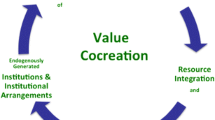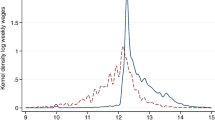Abstract
For many years, regulatory policy in the telecommunications industry has been strongly influenced by the belief that the traditional system of cross-subsidizing local rates by long distance has served to promote the goal of universal service. In this paper, we examine both the theoretical and empirical support for this widely accepted relationship and find it wanting in each. The results indicate that the cross-subsidization mechanism bears no causal relationship to the policy goal of universal service. Instead, both the subsidy levels and subscription rates appear to be determined by other economic variables, such as those suggested by the economic theory of regulation.
Similar content being viewed by others
References
Amemiya, T. 1976. “The Maximum Likelihood, the Minimum Chi-Square and the Nonlinear Weighted Least Squares in the General Qualitative Response Model”. Journal of the American Statistical Association 71 (June): 347–51.
AT&T Communications. 1984 and 1985. Internal documents.
Belsley, D.A., E. Kuh, and R.E. Welsch. 1980. Regression Diagnostics:Identifying Influential Data and Sources of Collinearity. New York: John Wiley and Sons.
Braeutigam, R. 1980. “An Analysis of Fully Distributed Cost Pricing in Regulated Industries”. Bell Journal of Economics 11(1): 182–196.
Cain, Paul E. and James M. MacDonald. 1989. “Telephone Pricing Structures: The Effects on Universal Service.” Paper presented at the Eighth Annual Conference of the Advanced Workship in Regulation and Public Utility Economics, Newport, Rhode Island, (May).
Congressional Budget Office. 1984. The Changing Telephone Industry: Access Charges, Universal Service, and Local Rates. Washington, D.C.: U.S. Government Printing Office.
Crew, Michael A. and Paul R. Kleindorfer. 1986. The Economics of Public Utility Regulation. Houndsmills, Basingstoke, Hampshire RG21 2X5: The MacMillan Press.
Evans, Lewis and Steven Garber. 1988. “Public Utility Regulators are Only Human: A Positive Theory of Rational Constraints”. American Economic Review 78 (June): 444–462.
Faulhaber, Gerald. 1975. “Cross-Subsidization: Pricing in Public Enterprises”. American Economic Review 65 (December): 966–977.
Faulhaber, Gerald. 1987. Telecommunication in Turmoil:Technology and Public Policy. Cambridge, Massachusetts: Ballinger Publishing Company.
Federal Communications Commission. 1988. Monitoring Report CC Docket No. 87–339. Washington, D.C.: FCC (March).
Griffin, James. 1982. “The Welfare Implications of Externalities and Price Elasticities for Telecommunications Pricing”. The Review of Economics and Statistics 64 (February): 59–66.
Hausman, J. A. 1978. “Specification Tests in Econometrics”. Econometrica 46 (November): 1251–71.
Johnson, Leland L. 1988. Telephone Assistance Programs for Low-Income Households: A Preliminary Assessment. Santa Monica: The Rand Corporation (February).
Joskow, Paul. 1974. “Inflation and Environmental Concerns: Structural Change in the Process of Public Utility Regulation”. Journal of Law and Economics 17 (October): 291–327.
Kahn, Alfred E. 1984. “The Road to More Intelligent Telephone Pricing”. Yale Journal on Regulation 1(2): 139–157.
Kahn, Alfred E. 1988. The Economics of Regulation: Principles and Institutions. Cambridge: The MIT Press.
Kaserman, David L. and John W. Mayo. 1988. “Long-distance Telecommunications Policy—Rationality on Hold”. Public Utilities Fortnightly 122(13): 18–27.
Leggette, James A. 1986. “Separations and Telecommunications Pricing Issues”. In Telecommunications in the Post-Divestiture Era, edited by A. Daniels and D. Kamershen. Lexington, MA: Lexington Books.
Maddala, G. S. 1983. Limited Dependent and Qualitative Variables in Econometrics. Cambridge: Cambridge University Press.
Mitchell, Bridger. 1978. “Optimal Pricing of Local Telephone Service”. American Economic Review 68 (September): 517–537.
National Association of Regulatory Utility Commissioners. 1986. Bell Operating Companies' Exchange Service Telephone Rates. Washington, D.C.: NARUC.
Peltzman, Sam. 1976. “Toward a More General Theory of Regulation”. Journal of Law and Economics 19 (August): 211–240.
Perl, Lewis. 1983. Residential Demand for Telephone Service. National Economic Research Associates, Inc.
Posner, Richard A. 1971. “Taxation by Regulation”. Bell Journal of Economics and Management Science 2 (Spring): 22–50.
Posner, Richard A. 1974. “Theories of Economic Regulation”. Bell Journal of Economics and Management Science 5 (Autumn): 335–358.
Ramsey, J.B. 1969. “Tests for Specification Errors in Classic Linear Least Squares Regression Analysis”. Journal of the Royal Statistical Society, Series B. 31: 350–371.
Ramsey, J. B. and P. Schmidt P. 1976. “Some Further Results on the Use of OLS and BLUS Residuals in Specification Error Tests”. Journal of the American Statistical Association 71 (June): 389–390.
Rholfs, Jeffrey. 1979. “Economically Efficient Bell System Pricing.” Bell Laboratories Discussion Paper.
Stigler, George. 1971. “The Theory of Economic Regulation”. Bell Journal of Economics and Management Science 2 (Spring): 3–21.
Sweeney, George. 1982. “An Analysis of Fully Distributed Cost Pricing Applied to Partially Regulated Firms”. Bell Journal of Economics 13(2): 525–533.
Taylor, Lester. 1980a. Telecommunications Demand: A Survey and Critique. Cambridge: Ballinger Publishing Company, 1980a.
Taylor, Lester. 1980b. “The Demand for Telecommunications: A Nontechnical Exposition”. In Issues in Public-Utility Pricing and Regulation, edited by Michael Crew. Lexington, MA: Lexington Books.
U.S. Department of Commerce. 1985. Statistical Abstract of the United States 1985. Washington, D.C.: USGPO.
U.S. Department of Commerce. Survey of Current Business 68(4): 75.
Vietor, Richard and Dekkers Davidson. 1985. “Economics and Politics of Deregulation: The Issue of Telephone Access Charges”. Journal of Policy Analysis and Management 5: 3–22.
Weingast, Barry R. and Mark J. Moran. 1983. “Bureaucratic Discretion or Congressional Control? Regulatory Policymaking by the Federal Trade Commission”. Journal of Political Economy 91 (October): 765–800.
Wenders, John T. 1987. The Economics of Telecommunications: Theory and Policy. Cambridge: Ballinger Publishing Company, 1987.
Author information
Authors and Affiliations
Rights and permissions
About this article
Cite this article
Kaserman, D.L., Mayo, J.W. & Flynn, J.E. Cross-subsidization in telecommunications: Beyond the universal service fairy tale. J Regul Econ 2, 231–249 (1990). https://doi.org/10.1007/BF00134062
Issue Date:
DOI: https://doi.org/10.1007/BF00134062




